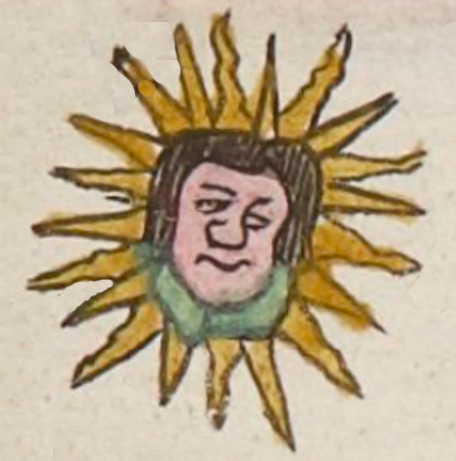Tonatiuh (TR46r)
This compound glyph has two elements. One is a sun (tonatiuh) in a European style, with a center and many golden rays of sunshine radiating around the center. At the center, interestingly, is the second element, a frontal view of a human face with a large nose, perhaps the face of the Spaniard Pedro de Alvarado (whom the Nahuas called "Tonatiuh"). His skin tone is pink. His hair is brown. He has a light green collar around his neck.
Stephanie Wood
The contextualizing image shows that this name glyph is attached to the head of a Spaniard, and the figure is glossed, "Pedro de Alvarado," and the glyph is glossed, "Sol."
Some Nahuatl hieroglyphs for Spaniards are fascinating for their considerable use of phonograms. But this glyph does not have phonetic qualities. Marc Zender (2018, 30) discusses this glyph.
Stephanie Wood
sol
1578
Jeff Haskett-Wood
Spanish names, nombres de españoles, suns, soles, Spaniards

Tonatiuh, the sun; a day, https://nahuatl.wired-humanities.org/content/tonatiuh
Marc Zender (2018, 30) analyzes this as: glyphic TONA, tōna[tiw].
El Sol
Stephanie Wood
The Codex Telleriano-Remensis is hosted on line by the Bibliothèque nationale de France.
https://gallica.bnf.fr/ark:/12148/btv1b8458267s/f117.item. We have taken this detail shot from the indicated folio.
This manuscript is not copyright protected, but please cite Gallica, the digital library of the Bibliothèque nationale de France or cite this Visual Lexicon of Aztec Hieroglyphs, ed. Stephanie Wood (Eugene, Ore.: Wired Humanities Projects, 2020–present).






